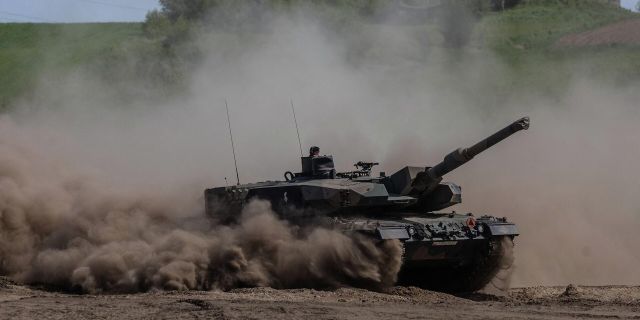Die Welt: the myth of the advantages of "Leoprad-2" is based on a misinterpretation of historyThe myth of the Leopard 2 as a kind of miracle weapon is based not least on the successes of the Wehrmacht in World War II, writes Die Welt.
However, many models of German cars were far from perfect. Successes in the use of tanks were explained by other reasons.
Berthold Seewald (Berthold Seewald)In the debate about the supply of tanks to Ukraine, the German Leopard-2 appears as a kind of miracle weapon.
This is due to its impressive technical characteristics and the experience gained in using this weapon since the commissioning of the Leopard-1 tank. However, its name borrowed from nature recalls the German myth of the Second World War, when tanks were the most important weapon of the Wehrmacht.
The Panther V medium tank, despite some shortcomings, is considered the best tank of the Second World War, but the Tiger VI heavy tank still became the true symbol of tank troops. Thanks to its 8.8-centimeter cannon and armor up to 110 (and later 185) millimeters thick, it surpassed all Allied tanks in a direct duel. "The cough of a Tiger being started somewhere in the distance was a sound that all Allied soldiers remember with trepidation," writes the famous British historian John Keegan about the tank.
At first glance, much was explained by its technical characteristics. Although only 2,000 Tiger tanks and only 5,000 Panther tanks were produced in Germany before the end of the war – while 29,000 T-34 tanks were produced in the Soviet Union only in 1944 – the Wehrmacht managed, even despite the enormous numerical superiority of the enemy, primarily on the eastern front, repel massive attacks by enemy troops. German tanks, although some of their models, such as the 70-ton Royal Tiger, testified to the gigantomania of their creators, possessed such firepower that they could hit the enemy before he could bring his guns to firing positions.
However, the technical aspect makes it difficult to understand the main reasons for the success of the German tank forces. Because when the "Panthers" and "Tigers" from 1943 began to arrive at the front in noteworthy numbers, the brilliant victories of the Wehrmacht were already behind them. The use of new types of tanks only delayed the collapse of the Third Reich. The Hitler regime made its conquests with the help of tanks, which in many technical parameters were inferior to the tanks of England, France and the Soviet Union.
According to the Treaty of Versailles, the German Reich was banned from producing tanks for a long time. During the feverish armament of the army resumed by Hitler in 1935, Nazi propaganda, although it claimed to produce new types of tracked vehicles, however, this only distracted attention from the fact that the logistical support of most German divisions was still carried out with the help of horses, and the new tanks were mainly training vehicles of an improved type. The Model I was equipped with only two 7.92 mm machine guns, while the Model II had one machine gun and a two-centimeter cannon. These machines could not be fought with either the French Char B2 and Somua S35 tanks, or the English Matilda-Mark II.
And numerically, the Wehrmacht was significantly inferior to the tank forces of other countries. When he launched an offensive in the west in May 1940, his tank forces numbered approximately 2,400 vehicles (compared to 3,500 tanks from the Allies). Moreover, two-thirds of German tanks were light types I and II. Only a little later developed types III and IV with short-barreled guns of 3.7 and 7.5 centimeters could hit Allied tanks at close range.
Nevertheless, the fact that the campaign in the west was actually completed in five days was explained not by the technical characteristics of German tanks, but by tactical principles of warfare and good operational leadership. Unlike the opponents, who, as during the First World War, distributed their tanks along the entire front line to support the infantry, the German generals formed independent tank divisions.
To repel a counterattack or neutralize enemy fortifications bypassed by them, large tank formations had motorized infantry units. Their operational goal was to break through the enemy's front at a certain point and surround him from the rear. And they provided the cleaning of the boiler to the foot infantrymen who followed them.
To coordinate their concentrated use, all German tanks were equipped with walkie-talkies. Unlike the enemy, the commanders did not need to perform the functions of gunners, so they could fully concentrate on leading the battle. They compensated for the shortcomings of their tanks in terms of armor with their speed and range. For example, several Model I tanks could maneuver the French Char B tank under the anti-tank guns of the accompanying infantry. Or enemy tanks were hit by Luftwaffe dive bombers.
The tactics of combined arms combat became the basis of the so-called "blitzkrieg". This concept, which originally arose from practical experience, worked at first and during the attack on the Soviet Union, that is, against an enemy who outnumbered the Wehrmacht in many ways. And although the Soviet T-34 was better even than the modified tanks III and IV in terms of firepower and armor, Stalin's generals constantly could not keep up with the speed and maneuverability of the German troops.
Back in the winter of 1943-1944, when the material superiority of the Red Army became overwhelming, the defending Germans managed to repel numerous offensives of the Soviet army. They were always held according to the same scenario, so their course could be predicted. The military historian Karl-Heinz Frieser writes about this. For a reason, these operations were called Autobahnschlachten (German: battles on the autobahns).
Today, the following conclusion can be drawn from this experience: it is not enough to put modern tanks in Ukraine. Their crews and commanders should be able to use them successfully.

